英语谚语教学计划
- 格式:docx
- 大小:24.55 KB
- 文档页数:4

英语论文之在初中英语教学中引入谚语英语中有许许多多的谚语,谚语的主要特点是言简意赅、寓义深广。
在英语教学中,我在初中英语教学中见缝插针,将谚语引入教学,收到了较好的效果。
具体做法如下:一.每日一句,逐渐积累。
在英语教学中,每天提供给学生一句谚语。
选择适合初中学生的谚语,这些谚语短小精悍,音韵和谐,琅琅上口,所含的道理通俗易懂,非常适合于背诵。
例如:No pains,no gains.(不劳无获)。
Grasp all, lose all.(贪多必失)。
Out of sight,out of mind.(眼不见,心不烦)。
Practice makes perfect.(熟能生巧)。
学生如果能够每天记忆一句谚语,长期坚持,定能由量变提升到质变,在特定的语言环境中脱口而出,受到贴切、生动、幽默、风趣等意想不到的语言效果。
二.对比中英谚语,理解不同文化。
语言和文化密不可分,中外之间存在着文化差异。
语言深深地扎根于文化的土壤中,离开了特定文化背景的语言是不存在的,二者血肉相连,不可分割。
中国文化远源流长,汉语中也有很多谚语。
如:“三个臭皮匠,顶个诸葛亮”在英语中则译为:“Two heads are better than one”。
不懂中国文化,就不可能正确理解、翻译。
有些英语谚语可以找到中文中与之相匹配的谚语,有些则没有。
在英语教学中,对英、汉谚语进行分析、比较,有助于学生更好地了解中西语言的深刻内涵和文化差异。
三.学以致用,举一反三。
语言的功能在于交际。
交际主要的两个方面是理解(他人)和表达(自己)。
表达能力的高低与语言信息的输入量和储存量有着密切的关系。
我们都知道:熟读唐诗三百首,不会作诗也会诌。
同样道理,熟读和记忆大量的英语语言材料对于学生来说是很有必要的。
坚持学习谚语有利于学生积累大量句型和词汇,供学生自己举一反三、模仿、套用和改写。
如:Where there is a will, there is a way.(有志者,事竟成)。

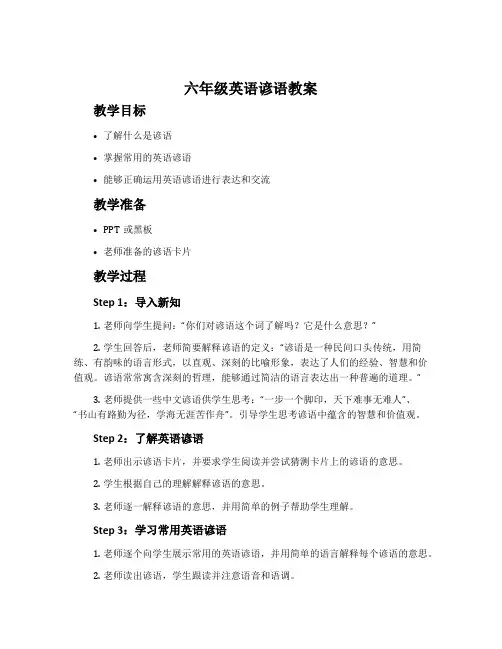
六年级英语谚语教案教学目标•了解什么是谚语•掌握常用的英语谚语•能够正确运用英语谚语进行表达和交流教学准备•PPT或黑板•老师准备的谚语卡片教学过程Step 1:导入新知1.老师向学生提问:“你们对谚语这个词了解吗?它是什么意思?”2.学生回答后,老师简要解释谚语的定义:“谚语是一种民间口头传统,用简练、有韵味的语言形式,以直观、深刻的比喻形象,表达了人们的经验、智慧和价值观。
谚语常常寓含深刻的哲理,能够通过简洁的语言表达出一种普遍的道理。
”3.老师提供一些中文谚语供学生思考:“一步一个脚印,天下难事无难人”、“书山有路勤为径,学海无涯苦作舟”。
引导学生思考谚语中蕴含的智慧和价值观。
Step 2:了解英语谚语1.老师出示谚语卡片,并要求学生阅读并尝试猜测卡片上的谚语的意思。
2.学生根据自己的理解解释谚语的意思。
3.老师逐一解释谚语的意思,并用简单的例子帮助学生理解。
Step 3:学习常用英语谚语1.老师逐个向学生展示常用的英语谚语,并用简单的语言解释每个谚语的意思。
2.老师读出谚语,学生跟读并注意语音和语调。
3.老师引导学生多次重复每个谚语,帮助他们牢记和理解谚语的含义。
Step 4:谚语运用练习1.老师将学生分成小组,并要求每个小组选择一个谚语,用英语创作一个小故事或短文。
2.学生在小组内讨论并编写自己的故事或短文,要求包含所选择的谚语,并在文中正确运用该谚语。
3.学生在小组内互相交流并修改各自的作品,确保语法和表达无误。
4.每个小组派代表上台朗读自己的作品,并解释所使用的谚语的意义。
Step 5:总结和延伸1.老师向学生总结所学的谚语,并鼓励他们在日常生活中运用英语谚语进行表达和交流。
2.学生积极参与讨论,分享谚语在生活中的实际运用情景。
教学扩展•学生可分组进行谚语说唱或演绎,通过音乐和舞台表演形式将谚语生动地呈现出来。
•学生可利用网络和图书进行进一步的谚语学习和探索,扩大自己的谚语知识库。
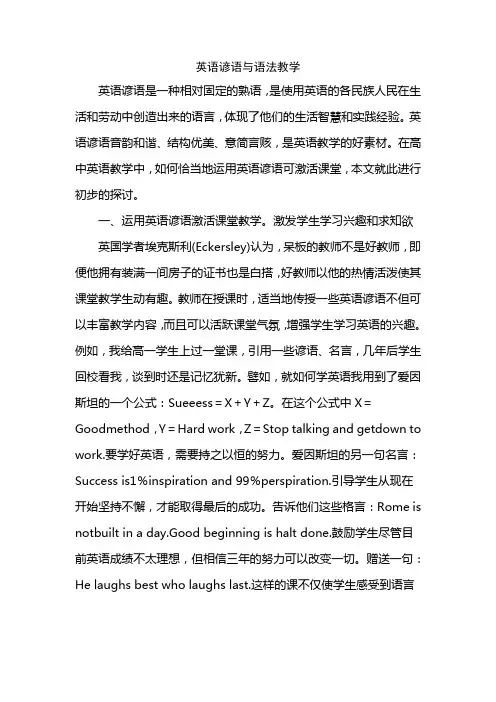
英语谚语与语法教学英语谚语是一种相对固定的熟语,是使用英语的各民族人民在生活和劳动中创造出来的语言,体现了他们的生活智慧和实践经验。
英语谚语音韵和谐、结构优美、意简言赅,是英语教学的好素材。
在高中英语教学中,如何恰当地运用英语谚语可激活课堂,本文就此进行初步的探讨。
一、运用英语谚语激活课堂教学。
激发学生学习兴趣和求知欲英国学者埃克斯利(Eckersley)认为,呆板的教师不是好教师,即便他拥有装满一间房子的证书也是白搭,好教师以他的热情活泼使其课堂教学生动有趣。
教师在授课时,适当地传授一些英语谚语不但可以丰富教学内容,而且可以活跃课堂气氛,增强学生学习英语的兴趣。
例如,我给高一学生上过一堂课,引用一些谚语、名言,几年后学生回校看我,谈到时还是记忆犹新。
譬如,就如何学英语我用到了爱因斯坦的一个公式:Sueeess=X+Y+Z。
在这个公式中X=Goodmethod,Y=Hard work,Z=Stop talking and getdown to work.要学好英语,需要持之以恒的努力。
爱因斯坦的另一句名言:Success is1%inspiration and 99%perspiration.引导学生从现在开始坚持不懈,才能取得最后的成功。
告诉他们这些格言:Rome is notbuilt in a day.Good beginning is halt done.鼓励学生尽管目前英语成绩不太理想,但相信三年的努力可以改变一切。
赠送一句:He laughs best who laughs last.这样的课不仅使学生感受到语言积累的重要性,而且让英语课堂生动有趣,带动学生学习热情,激发其求知欲。
同时为进一步运用谚语教学奠定了良好的基础。
二、英语谚语在教学中的运用1. 借助英语谚语渗透词汇教学根据《普通高中英语课程标准》,高中生应掌握3500词左右,比旧大纲几乎增加了一倍。
牛津高中英语教材的词汇比以往教材大大增加,对高中教师而言,这无疑是个很大的挑战。
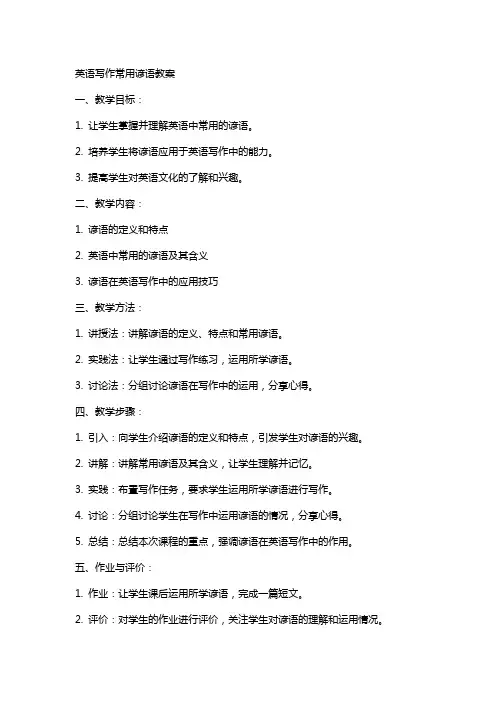
英语写作常用谚语教案一、教学目标:1. 让学生掌握并理解英语中常用的谚语。
2. 培养学生将谚语应用于英语写作中的能力。
3. 提高学生对英语文化的了解和兴趣。
二、教学内容:1. 谚语的定义和特点2. 英语中常用的谚语及其含义3. 谚语在英语写作中的应用技巧三、教学方法:1. 讲授法:讲解谚语的定义、特点和常用谚语。
2. 实践法:让学生通过写作练习,运用所学谚语。
3. 讨论法:分组讨论谚语在写作中的运用,分享心得。
四、教学步骤:1. 引入:向学生介绍谚语的定义和特点,引发学生对谚语的兴趣。
2. 讲解:讲解常用谚语及其含义,让学生理解并记忆。
3. 实践:布置写作任务,要求学生运用所学谚语进行写作。
4. 讨论:分组讨论学生在写作中运用谚语的情况,分享心得。
5. 总结:总结本次课程的重点,强调谚语在英语写作中的作用。
五、作业与评价:1. 作业:让学生课后运用所学谚语,完成一篇短文。
2. 评价:对学生的作业进行评价,关注学生对谚语的理解和运用情况。
教学反思:本教案旨在帮助学生掌握英语中常用的谚语,并将其应用于写作中。
在教学过程中,教师应关注学生的学习兴趣,通过实践和讨论,提高学生对谚语的理解和运用能力。
教师应及时给予反馈,指导学生正确运用谚语,提高英语写作水平。
六、教学内容拓展:1. 谚语的起源和文化背景2. 英语谚语与其他语言谚语的对比3. 谚语在英语文学作品中的应用七、教学活动:1. 寻找谚语起源:让学生调查并介绍自己喜欢的谚语的起源和文化背景。
2. 跨文化比较:让学生研究其他语言中的类似谚语,并进行对比分析。
3. 文学探索:让学生阅读英语文学作品,找出其中的谚语,并分析其作用。
八、教学资源:1. 谚语起源和文化背景的资料2. 跨文化谚语比较的参考书籍和文章3. 英语文学作品的推荐列表九、教学评估:1. 学生对谚语起源和文化背景的了解程度2. 学生对跨文化谚语比较的分析和理解能力3. 学生对英语文学作品中谚语的识别和分析能力十、教学延伸:1. 邀请英语母语者分享他们的谚语和文化背景2. 组织学生参加谚语创意写作比赛3. 开展谚语文化研究项目,让学生深入探索谚语在各个文化中的作用和意义十一、教学策略的调整:1. 针对学生的学习反馈,适时调整教学进度和难度。

英语谚语在小学英语课堂中的应用一、引言英语谚语以其简洁、富有哲理的语言特点,一直以来都是语言学习的重要组成部分。
对于小学生来说,这些富有智慧的谚语不仅可以丰富他们的词汇量,提高他们的语言表达能力和理解能力,还可以培养他们的文化意识和跨文化交际能力。
因此,将英语谚语引入小学英语课堂,无疑是一种有益的教学尝试。
本文将探讨如何在小学英语课堂中应用英语谚语,以丰富课堂教学内容,提高学生的学习兴趣和语言应用能力。
二、英语谚语在小学英语课堂中的应用1.导入环节:激发兴趣在英语课堂上,教师可以利用一些有趣的英语谚语来吸引学生的注意力,激发他们的学习兴趣。
例如,“A friend in need is a friend indeed.”(患难见真情)和“Where there is a will, there is a way.”(有志者事竟成)这些谚语既简单易懂,又富有哲理,能够很好地引起学生的共鸣。
在导入环节中,教师可以让学生尝试翻译这些谚语,锻炼他们的词汇和语法能力,同时培养他们的文化意识和跨文化交际能力。
2.新课讲解:加深理解在讲解新课的过程中,教师可以穿插一些与课文内容相关的英语谚语,帮助学生加深对课文的理解。
例如,在讲解“颜色”这一主题时,可以引入“Red means stop, green means go.”(红停绿行)的谚语,帮助学生更好地理解交通标志的含义。
此外,教师还可以引导学生思考这些谚语与课文主题之间的联系,培养他们的思维能力和语言运用能力。
3.拓展环节:丰富知识在拓展环节中,教师可以引导学生学习更多的英语谚语,拓宽他们的知识面。
例如,“It is never too late to learn.”(活到老,学到老)和“Actions speak louder than words.”(行动胜于言语)等。
教师可以通过小组合作的方式,让学生进行讨论、翻译和分享,培养他们的合作意识和语言表达能力。

小学英语教学中的英语谚语学习一、引言英语谚语是英语语言中的精华,是英语民族智慧的结晶。
它们以言简意赅、寓意深刻的特性,传递着生活的哲理。
对于小学生来说,学习并理解这些谚语不仅可以提高他们的英语表达能力,还能培养他们的思维能力和文化意识。
本文将探讨小学英语教学中英语谚语学习的意义、方法和效果。
二、英语谚语学习的意义1.提高语言表达能力:英语谚语言简意赅,富有韵律,是很好的口语表达素材。
通过学习英语谚语,小学生可以丰富语言表达,提高口语表达能力。
2.培养思维能力:英语谚语往往蕴含着深刻的道理,需要学生通过思考、理解才能领会。
这一过程有助于培养学生的逻辑思维能力和理解能力。
3.增强文化意识:英语谚语往往带有明显的文化色彩,通过学习英语谚语,学生可以了解英语国家的文化背景,增强文化意识。
三、英语谚语学习的方法1.精选材料:教师应选择适合小学生理解水平的英语谚语,难度不宜过高。
同时,应注重谚语的积极意义,选择有教育意义的谚语。
2.课堂讲解:教师在讲解英语谚语时,应先解释生词和难点语法,确保学生理解谚语含义。
然后,通过讲解背后的故事或文化背景,帮助学生理解其寓意。
3.情境应用:教师可设计情境对话或写作任务,让学生运用所学英语谚语进行表达。
通过实际应用,加深学生对谚语的理解和记忆。
4.合作学习:鼓励学生分组学习,互相分享各自所知的英语谚语,并讨论其含义。
通过合作学习,学生可以相互学习,共同进步。
5.定期复习:为避免学生遗忘所学英语谚语,教师应定期组织复习。
可以采用小组讨论、角色扮演、游戏等形式,帮助学生巩固记忆。
四、英语谚语学习的效果1.语言表达能力提高:通过学习英语谚语,小学生的口语和书面表达能力得到显著提高。
他们能够灵活运用所学谚语进行表达,使表达更加生动、有力。
2.思维品质提升:在理解英语谚语的过程中,小学生需要透过表面现象洞察其内在含义,这有助于培养他们的逻辑思维和判断思维能力。
3.文化意识增强:通过学习英语谚语,小学生能够了解英语国家的文化背景,增强他们的文化意识,拓宽他们的视野。

关于动物的谚语总结一、教学目标:A:语言目标:巧用谚语,提高学生学习兴趣B:能力目标:巧用谚语,培养学生的语言综合运用能力C:德育目标:巧用谚语,培养学生的逻辑表述能力,激发学生的积极思维,帮助学生了解中西方文化差异。
二、教学重点:英语谚语的逻辑记忆能力三、教学难点:语文谚语的掌握程度,英语单词的掌握四、教学用具:幻灯片,手头复印谚语,和文章五、教学过程:Step1:Leading-in:let students talk different culture about dogs in China and Western and express their different ideas. And let them know something about Snoopy.Step2:Work in groups of four . Give them several minutes to discuss some proverbs about dogs. And check.Step3:PK. Divide the whole class into four groups. Discuss and check some proverbs about different animals.(1)as timid as a hare 胆小如鼠(2)as strong as horse. 体壮如牛(3)a cat-and-dog life 争争吵吵的日子(4)It's raining cats and dogs. 倾盆大雨(5)The cat is out of the bag. 泄露了秘密;走漏了风声(6)The early bird catches the worm. 早起的鸟儿有虫吃。
(7)When the cat's away, the mice will play. 猫儿不在,老鼠成精;大王外出, 小鬼跳粱(8)Never offer to teach fish to swim. 不要班门弄斧。
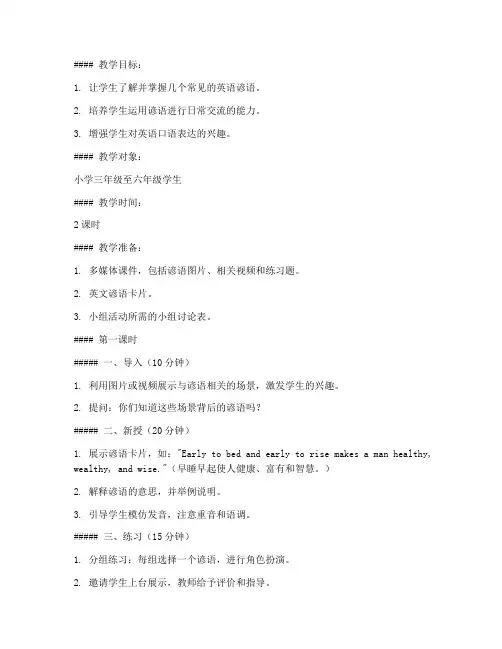
#### 教学目标:1. 让学生了解并掌握几个常见的英语谚语。
2. 培养学生运用谚语进行日常交流的能力。
3. 增强学生对英语口语表达的兴趣。
#### 教学对象:小学三年级至六年级学生#### 教学时间:2课时#### 教学准备:1. 多媒体课件,包括谚语图片、相关视频和练习题。
2. 英文谚语卡片。
3. 小组活动所需的小组讨论表。
#### 第一课时##### 一、导入(10分钟)1. 利用图片或视频展示与谚语相关的场景,激发学生的兴趣。
2. 提问:你们知道这些场景背后的谚语吗?##### 二、新授(20分钟)1. 展示谚语卡片,如:"Early to bed and early to rise makes a man healthy, wealthy, and wise."(早睡早起使人健康、富有和智慧。
)2. 解释谚语的意思,并举例说明。
3. 引导学生模仿发音,注意重音和语调。
##### 三、练习(15分钟)1. 分组练习:每组选择一个谚语,进行角色扮演。
2. 邀请学生上台展示,教师给予评价和指导。
##### 四、总结(5分钟)1. 回顾本节课所学谚语。
2. 鼓励学生在日常生活中尝试使用这些谚语。
#### 第二课时##### 一、复习(10分钟)1. 通过提问的方式,复习上一节课学过的谚语。
2. 邀请学生分享他们在日常生活中如何运用这些谚语。
##### 二、拓展(20分钟)1. 展示更多谚语卡片,让学生猜出谚语的意思。
2. 引导学生思考谚语背后的文化内涵。
##### 三、活动(15分钟)1. 小组活动:每个小组选择一个谚语,设计一个小故事,并用英语进行讲述。
2. 小组间互相展示,其他小组进行评价。
##### 四、总结(5分钟)1. 回顾本节课所学内容。
2. 鼓励学生在接下来的学习中继续积累和运用英语谚语。
#### 教学反思:1. 关注学生的学习兴趣,通过多种方式激发学生对英语谚语的兴趣。

英语谚语教学范文作为一种常见的英语语言形式,谚语被广泛应用在口语和英文写作中,它们涉及许多日常生活方面。
谚语是一段简短的话语,它通常表达出一个普遍的真理或经验,可以引导、教育或启发听众。
如今,教师们正越来越多地利用这种语言形式来引导学生学习英语。
本文将详细介绍英语谚语教学的重要性并探讨一些教学技巧以及如何将英语谚语教学融入到课程中。
英语谚语教学的重要性英语谚语作为一种文学形式,具有深远的意义和价值。
它们是英语语言的基础知识,这是因为它们具有固定的结构和语法规则,可以帮助学生学习语言的语法、用法和表达方式。
谚语涉及到文化、历史、民俗和惯例等方面,可以帮助学生了解不同国家和地区的差异和共性。
谚语有助于学生更好地理解和母语的相似之处,以及英语中的文化底蕴。
它们也可以拓宽学生的词汇,促进他们的口头表达和写作能力。
教学技巧英语谚语教学需要教师在讲述知识时举一反三,在有趣的语言表达方面引导学生,以下几点是教师在实践中可能用到的技巧:(1)根据学生的程度选择谚语英语谚语通常种类繁多,学生的口头和写作能力也具有不同的水平。
因此,在教学上,教师应该选取适合学生的英语谚语,以使他们更好地理解和掌握它。
(2)应用多种教学手段为了鼓励学生学习英语谚语和提高他们的语言技能,教师可以采用各种教学手段,如多媒体教学、互动游戏和小组活动等。
其中,小组活动是最重要的教学方法之一,对于学生来说,它可以吸引他们的兴趣,增加他们的参与感,并且让学生更好地理解和应用英语谚语。
(3)跨学科教学英语谚语涉及到多方面的文化和知识,因此,教师可以将教学与其他学科相结合,以便学生更好地应用和理解英语谚语。
例如,历史老师可以帮助学生了解英国著名的谚语,如"牛顿的苹果";社会研究老师可以与学生分享与不同文化相关的谚语、俚语等。
(4)制定教学计划为了确保课堂上的谚语教学顺利进行,教师需要制定详细的教学计划。
计划应包括谚语的类型和每堂课的教学目标,包括谚语的背景和意义等内容。
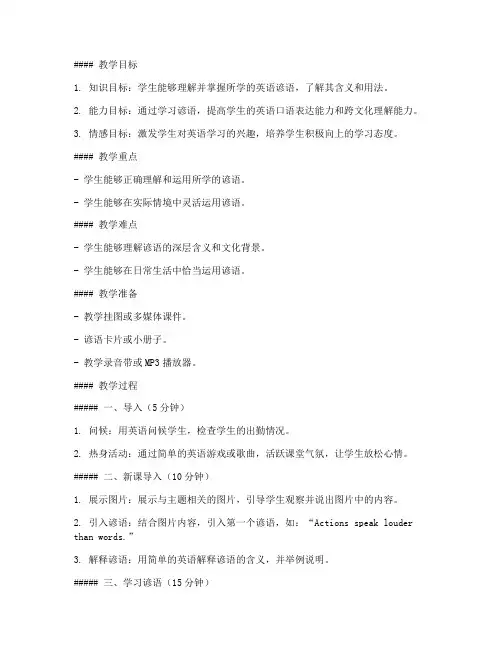
#### 教学目标1. 知识目标:学生能够理解并掌握所学的英语谚语,了解其含义和用法。
2. 能力目标:通过学习谚语,提高学生的英语口语表达能力和跨文化理解能力。
3. 情感目标:激发学生对英语学习的兴趣,培养学生积极向上的学习态度。
#### 教学重点- 学生能够正确理解和运用所学的谚语。
- 学生能够在实际情境中灵活运用谚语。
#### 教学难点- 学生能够理解谚语的深层含义和文化背景。
- 学生能够在日常生活中恰当运用谚语。
#### 教学准备- 教学挂图或多媒体课件。
- 谚语卡片或小册子。
- 教学录音带或MP3播放器。
#### 教学过程##### 一、导入(5分钟)1. 问候:用英语问候学生,检查学生的出勤情况。
2. 热身活动:通过简单的英语游戏或歌曲,活跃课堂气氛,让学生放松心情。
##### 二、新课导入(10分钟)1. 展示图片:展示与主题相关的图片,引导学生观察并说出图片中的内容。
2. 引入谚语:结合图片内容,引入第一个谚语,如:“Actions speak louder than words.”3. 解释谚语:用简单的英语解释谚语的含义,并举例说明。
##### 三、学习谚语(15分钟)1. 谚语展示:展示更多与主题相关的谚语,如:“A stitch in time saves nine.”、“Practice makes perfect.”2. 小组讨论:将学生分成小组,要求每个小组选择一个谚语,进行讨论并解释其含义。
3. 全班分享:每组派代表分享他们的谚语和讨论结果。
##### 四、谚语应用(15分钟)1. 情景模拟:设计一个简单的情景,让学生运用所学谚语进行对话。
2. 角色扮演:让学生分组进行角色扮演,运用谚语进行对话。
##### 五、巩固练习(10分钟)1. 谚语接龙:学生轮流说出谚语,下一个人需要接上上一个谚语的最后一个词,形成新的谚语。
2. 谚语填空:给出一句不完整的谚语,让学生填写缺失的部分。
一、教案基本信息英语写作常用谚语教案课时安排:45分钟教学目标:1. 学生能够理解并记忆常用的英语谚语。
2. 学生能够在写作中正确运用这些谚语,提高写作水平。
3. 学生能够通过谚语学习,加深对英语文化背景的了解。
教学材料:1. PPT展示谚语及例句2. 写作练习题目二、教学步骤1. 导入(5分钟)教师通过PPT展示一些图片,引导学生猜测与之相关的谚语。
例如,展示一张图片上有两个人在抬石头,让学生猜测与之相关的谚语“Two heads are better than one.”。
2. 谚语学习(10分钟)教师通过PPT展示每个谚语的含义、出处及例句,让学生跟读并理解其含义。
鼓励学生分享自己知道的类似谚语,增加课堂互动。
例如:“A stitch in time saves nine.”:及时采取措施可以避免更大的麻烦。
“All work and no play makes Jack a dull boy.”:只工作不玩耍,聪明孩子也变傻。
3. 写作练习(15分钟)教师给出一个写作题目,要求学生运用所学的谚语进行写作。
例如:“你最喜欢的季节是什么?请用至少两个谚语来描述。
”4. 学生展示(5分钟)学生将自己的写作成果展示给全班同学,并解释自己是如何运用谚语的。
其他同学可以提问或给予反馈。
5. 总结与反思(5分钟)教师引导学生总结今天学到的谚语,并鼓励他们在日常写作中多加运用。
教师也可以收集学生对谚语学习的反馈,以便更好地调整教学方法。
三、课后作业要求学生课后运用至少三个新学的谚语完成一篇短文,题目自选。
四、教学评估通过课后作业的完成情况,评估学生对谚语的理解和运用能力。
观察课堂上学生的参与度和互动情况,了解他们对谚语学习的兴趣和效果。
五、教学反思在下一个教学周期中,根据学生的反馈和教学评估结果,调整教学内容和方式,以提高学生对英语谚语学习的兴趣和效果。
六、教学扩展活动1. 谚语游戏(10分钟)教师设计一个谚语接龙游戏,学生需要根据前一个谚语的意思接出一个新的谚语。
动物英语谚语课程设计一、教学目标本课程旨在通过学习动物英语谚语,让学生掌握相关动物词汇和表达方式,提高学生的英语听说读写能力。
具体目标如下:1.知识目标:学生能够理解并正确使用与动物相关的英语谚语,掌握谚语中的重点词汇和语法结构。
2.技能目标:学生能够运用所学的动物英语谚语进行日常交流,提高英语口语表达能力和听力理解能力。
3.情感态度价值观目标:通过学习动物英语谚语,学生能够培养对动物的关爱和保护意识,提高人文素养。
二、教学内容本课程的教学内容主要包括以下几个部分:1.动物英语谚语的基本概念和特点,介绍与动物相关的英语谚语及其含义。
2.重点词汇和短语的学习,包括动物名称、形容词、动词等,并通过例句展示其在谚语中的应用。
3.谚语的语法结构分析,讲解谚语中的主谓宾、定状补等成分,帮助学生正确使用谚语。
4.听力练习,播放与动物英语谚语相关的听力材料,提高学生的听力理解能力。
5.口语练习,学生分组进行角色扮演,运用所学的动物英语谚语进行日常交流。
三、教学方法为了提高教学效果,本课程将采用以下几种教学方法:1.讲授法:教师讲解动物英语谚语的基本概念、重点词汇和语法结构。
2.讨论法:学生分组讨论谚语的含义和用法,促进互动交流。
3.案例分析法:通过分析典型动物英语谚语案例,让学生深入理解谚语的意义。
4.实验法:学生进行情景剧创作,运用所学的动物英语谚语进行表演,提高学生的实际应用能力。
四、教学资源为了支持教学内容和教学方法的实施,我们将准备以下教学资源:1.教材:选用权威、实用的英语教材,提供丰富、多样的学习材料。
2.参考书:推荐学生阅读与动物英语谚语相关的书籍,拓展知识面。
3.多媒体资料:制作精美的PPT、视频、音频等多媒体教学资源,提高学生的学习兴趣。
4.实验设备:准备必要的实验设备,如录音机、投影仪等,确保教学活动的顺利进行。
五、教学评估本课程的教学评估将采用多元化方式,全面、客观地评价学生的学习成果。
谚语英语学习计划小学IntroductionEnglish is a widely spoken language and is an important skill to have in today's globalized world. One way to improve my English language skills is by learning and understanding English proverbs. Proverbs are short, pithy sayings that offer wisdom or advice about life. By learning and understanding proverbs, I can expand my vocabulary, improve my comprehension of the language, and gain a deeper understanding of English culture and customs. In this essay, I will outline my plan for learning English through proverbs, including the resources I will use, the activities I will engage in, and the goals I hope to achieve.ResourcesTo begin my journey of learning English through proverbs, I will gather resources that will help me in this endeavor. The first resource I will use is a collection of English proverbs. I will search for books, websites, and apps that provide a comprehensive list of English proverbs, along with their meanings and usage. Some recommended resources for finding English proverbs are "The Oxford Dictionary of Proverbs," "The Penguin Dictionary of Proverbs," and websites such as Proverb Hunter, where I can find a wide variety of proverbs with explanations and examples of usage.In addition to finding collections of proverbs, I will also seek out resources that provide explanations and interpretations of the proverbs. This will help me to understand the cultural and historical context of the proverbs, as well as how they are used in everyday speech. I will look for books, articles, and videos that delve into the meanings and origins of English proverbs, as well as how they are used in conversations and writing.ActivitiesWith my resources in hand, I will engage in a variety of activities to learn and understand English proverbs. The first activity I will undertake is to read and study a collection of proverbs. I will start by reading through a list of proverbs and their meanings, taking note of any new vocabulary words or idiomatic expressions that I encounter. To aid in my understanding, I will also look for examples of the proverbs being used in conversation, writing, or in popular culture.Once I have familiarized myself with a selection of proverbs, I will practice using them in my own speech and writing. I will make a conscious effort to incorporate proverbs into my daily conversations, as well as to use them in essays, emails, and other forms of written communication. Practicing using proverbs in context will help me to internalize their meanings and usage, and will also improve my overall fluency in English.Another activity I will engage in is to discuss proverbs with native English speakers. I will seek out opportunities to have conversations with English speakers about proverbs, askingthem about their favorite proverbs, their meanings, and when and how they are used. Engaging in conversations about proverbs will not only help me to improve my conversational skills, but will also deepen my understanding of the cultural and social aspects of English proverbs.GoalsI have set several goals for myself as I embark on my journey of learning English through proverbs. My first goal is to expand my vocabulary. By learning and understanding English proverbs, I will encounter new words and idiomatic expressions that are commonly used in the language. I hope to learn at least 100 new vocabulary words from studying proverbs, and to use them in my speech and writing.My second goal is to improve my comprehension of English. By reading, studying, and practicing using proverbs, I will develop a deeper understanding of the language. I aim to become more proficient in understanding the meanings and nuances of English proverbs, and to be able to recognize and use them in context.My final goal is to gain insight into English culture and customs. Proverbs are a reflection of a culture's values, beliefs, and traditions, and by learning English proverbs, I hope to gain a deeper understanding of English culture. I aim to learn about the historical and cultural contexts of different proverbs, as well as how they are used in everyday life in English-speaking countries.ConclusionLearning English through proverbs is a valuable and enjoyable way to improve my language skills. By gathering resources, engaging in activities, and setting goals for my study of proverbs, I hope to expand my vocabulary, improve my comprehension of English, and gain a deeper understanding of English culture and customs. I am excited to begin this journey and look forward to the knowledge and skills I will gain from learning English through proverbs.。
谚语活动方案英文回答:Proverbs are a powerful tool for teaching and learning. They are short, memorable sayings that express a universal truth or lesson. Proverbs can be used to teach children about values, morals, and life lessons. They can also be used to help children develop their critical thinkingskills and their ability to understand and apply figurative language.Here are some examples of how I use proverbs in my classroom: 。
When I want to teach my students about the importanceof hard work, I tell them the proverb, "No pain, no gain." 。
When I want to teach them about the importance of patience, I tell them the proverb, "Slow and steady winsthe race." 。
When I want to teach them about the importance of kindness, I tell them the proverb, "Treat others as you would want to be treated."Proverbs are a valuable resource for teachers and parents alike. They can be used to teach children about a wide range of topics, and they can help children develop their critical thinking skills and their ability to understand and apply figurative language.中文回答:谚语是一种用于教学和学习的强大工具。
谚语英语学习计划初中Ⅰ. IntroductionProverbs are an important part of English language and culture. They offer wisdom, advice, and insight into human nature and the world around us. Learning English proverbs can help students improve their language proficiency, expand their cultural knowledge, and enhance their understanding of life. Therefore, developing a comprehensive and effective plan for learning English proverbs is of great significance for middle school students. In this plan, we will outline a series of learning activities and strategies to help students master English proverbs and use them skillfully in their daily communication.Ⅱ. Objectives1. To familiarize students with a wide range of English proverbs and their meanings.2. To help students understand the cultural and historical background of English proverbs.3. To enable students to apply English proverbs appropriately in various contexts.4. To enhance students' language proficiency and critical thinking skills through the study of English proverbs.Ⅲ. Learning Activities1. Proverb Recognition- Introduce a new proverb to students in each class, along with its meaning and usage.- Provide examples and illustrations to help students understand the context in which each proverb is used.- Ask students to create their own sentences using the new proverb to demonstrate their understanding.- Encourage students to share their thoughts and interpretations of the proverbs with classmates.2. Proverb Analysis- Organize group discussions or debates on the meanings and implications of selected proverbs.- Encourage students to conduct research on the historical background and cultural significance of specific proverbs.- Invite students to explore the similarities and differences between English proverbs and proverbs from other cultures.3. Proverb Application- Design scenarios or role-playing activities for students to apply proverbs in real-life situations.- Challenge students to write essays or stories incorporating multiple proverbs to demonstrate their mastery of the language.- Provide opportunities for students to give presentations on specific proverbs and their relevance to contemporary issues.Ⅳ. Learning Resources1. Textbooks and Reference Materials- Use English language textbooks and reference books to introduce students to a wide range of proverbs and their meanings.- Provide students with access to online resources, such as databases and websites, for further exploration of English proverbs.2. Multimedia Materials- Utilize audio and video recordings of native English speakers using proverbs in conversations and speeches to enhance students' listening and speaking skills.- Incorporate visual aids, such as posters and multimedia presentations, to illustrate the meanings and contexts of various proverbs.3. Cultural and Historical Sources- Introduce students to English literature, folklore, and historical documents that contain proverbs, such as the works of Shakespeare and the Bible.- Organize field trips or cultural events to expose students to the cultural traditions and practices associated with English proverbs.Ⅴ. Assessment1. Proverb Quizzes- Administer regular quizzes to test students' knowledge of English proverbs, their meanings, and proper usage in sentences.- Include both written and oral components in the quizzes to evaluate students' reading, listening, and speaking skills.2. Proverb Assignments- Assign students writing tasks that require them to analyze, interpret, and apply proverbs in different contexts, such as writing essays, stories, or speeches.- Assess the quality of students' assignments based on their understanding of proverbs, language proficiency, and critical thinking abilities.3. Proverb Presentations- Evaluate students' ability to present and explain specific proverbs to their peers, as well as their understanding of the cultural and historical background of the proverbs.- Provide constructive feedback to help students improve their presentation skills and deepen their understanding of English proverbs.Ⅵ. ConclusionBy following this comprehensive learning plan, middle school students will be able to master a wide range of English proverbs, understand their meanings and contexts, and apply them effectively in their communication. Through the study of English proverbs, students will not only improve their language proficiency but also develop their cultural awareness and critical thinking skills. This learning plan aims to cultivate students' appreciation for English proverbs and their role in shaping language and culture.。
谚语英语学习计划小学生Introduction:English is a global language that is spoken and understood by people all over the world. As a student, it is important for me to learn and improve my English language skills, as it will open up many opportunities for me in the future. In order to achieve this goal, I have created a detailed plan that outlines how I will improve my English skills over the next year.Goals:My main goal is to improve my English speaking, listening, reading, and writing skills. I also want to expand my vocabulary and grammar knowledge. By the end of the year, I hope to be able to hold a conversation in English with confidence, read and understand English texts without difficulty, and write essays and stories in English.Daily Routine:To achieve my goals, I have created a daily routine that will allow me to practice and improve my English skills consistently. My daily routine will include the following activities:1. Reading:I will read English books, newspapers, and magazines for at least 30 minutes every day. This will help me to improve my reading comprehension and vocabulary.2. Writing:I will write in English for at least 20 minutes every day. I will write journal entries, essays, and stories to practice my writing skills and improve my grammar and vocabulary.3. Speaking:I will practice speaking in English by having conversations with my family members, friends, and classmates. I will also participate in English-speaking activities such as debates and presentations at school.4. Listening:I will listen to English audio materials such as podcasts, news broadcasts, and songs for at least 20 minutes every day. This will help me to improve my listening comprehension and pronunciation.Weekly Activities:In addition to my daily routine, I will also engage in weekly activities that will help me to improve my English skills. These activities will include:1. English Classes:I will attend English classes at school and participate actively in class discussions and activities. I will also ask my teachers for feedback on my English language skills and areas for improvement.2. Vocabulary Building:I will set aside time each week to learn new English vocabulary words. I will create flashcards with new words and their meanings, and review them regularly to expand my vocabulary.3. Grammar Practice:I will practice English grammar exercises and quizzes to improve my grammar skills. I will also seek help from my teachers and use online resources to clarify any doubts I may have about grammar rules.4. Speaking Practice:I will participate in English-speaking clubs or groups to practice my speaking skills with other English learners. I will also seek out opportunities to speak with native English speakers to improve my fluency and pronunciation.Monthly Assessments:At the end of each month, I will assess my progress in English language learning. I will review my daily and weekly activities to see what has worked well and what needs improvement. I will also set new goals for the following month based on my assessment.Challenges and Solutions:Learning a new language can be challenging, and I anticipate that I may encounter difficulties along the way. However, I have identified some common challenges and have come up with solutions to overcome them:1. Lack of Motivation:To stay motivated, I will remind myself of the benefits of learning English, such as improved communication skills and better career opportunities. I will also reward myself for achieving milestones in my English learning journey.2. Difficulty in Pronunciation:I will practice pronunciation by listening to native speakers and mimicking their intonations and speech patterns. I will also seek feedback from my teachers and peers to improve my pronunciation.3. Time Management:I will prioritize my English learning activities and set aside dedicated time each day to practice English. I will also use time management tools such as a study schedule or planner to stay organized.Conclusion:With a well-thought-out plan and consistent effort, I am confident that I will be able to improve my English language skills over the next year. I will track my progress regularly and make adjustments to my plan as needed to ensure that I stay on track to achieve my goals. I am excited to see how much I will improve and grow as an English learner through this learning plan.。
英语谚语教学计划
导读:制定计划,最主要的目的就是为了更有效的对孩子进行教育。
教学计划,是教师有效开展工作的必要保证。
但各位教师千万不要忘记制定计划的初衷,不然只能让自己的教学计划流于形式。
英语谚语教学计划应该怎么设计?
英语谚语教学计划
一、教学目标
如今英语在社会中地位甚为重要,在以人为本的教育理念指导下,班级特色应时刻围绕有利于学生的发展为目标。
我们以英语为特色,通过英语谚语的学习,可以帮助学生了解英语民族的风俗习惯、文化背景。
学习英语谚语,即能得到启发,又能得到英语的自然熏陶。
教师精选一些谚语学生进行思想品德教育,既能让学生接触到地道的英语语言,又能得到精神享受,真正达到了教书育人的目的。
英语谚语具有很高的艺术性,它能激发学生学习英语的兴趣,培养英语语感。
通过对学生进行听说读写,尤其是听和说的基本训练,激发学生学习英语的兴趣,培养学生学习英语的良好习惯,帮助学生树立学好英语的自信心;使学生获得对英语的感性认识,打下扎实的语音语调基础,并获得初步的英语听说能力,为继续学好英语作好准备。
二、学习主要策略及具体措施
1、进行每周至少两句英语谚语的学习、背诵、识记。
2、利用课前和早间一分钟时间进行朗读,达到熟能生巧。
3、在教师布置中贴上常用英语谚语及名言,营造英语学习气氛。
4、提倡学生在平时用自己熟悉的英语和同学老师进行交流。
愿意运用所学的对话、句型和同伴、老师进行交流。
5、了解英美文化,欣赏英文经典歌曲、电影、动画片等等。
尝试欣赏一些有趣的故事,了解其中的内容。
6、让孩子多说、多听,结合一日活动的各个环节,继续学习一些日常用语,礼貌用语,愿意在日常生活中加以运用,大胆地说。
7、通过谚语,学习单词(动作、玩具、生活用品、文具、食品、星期等),掌握一些简短的儿歌、歌曲、故事,并乐意和主动参加一些英语的情景和故事表演。
8、对教师的常规用语可以快速准确的做出反应。
三、学习进度计划
三月:
1、学习比较简单的、容易记忆的、学生易于理解的英语谚语8句。
(每周两条)如:Wellbegunishalfdone.好的开始是成功的一半。
EverydayisnotSunday.好景不常在。
2、在班中开设英语角,让孩子多说、多听。
3、获取家长的支持、配合,努力达到家校同步教育。
四月:
1、记忆有一定难度的、语句较长的句子8句。
(每周两句)
如:Manyheadsarebetterthanone.三个臭皮匠,赛过诸葛亮。
Constantdrippingwearsawayastone.水滴石穿,绳锯木断。
2、根据学生的学习水平发展水平,科学有序的合理安排英语活
动。
3、增加墙面也说话的作用,粘贴各种相关的英语句子,让孩子置身于学习英语的良好氛围中。
五月:
1、在一上基础上继续背诵句子至少5句,并及时对以上句子进行巩固于提高。
包括:Losersarealwaysinthewrong.胜者为王,败者为寇。
Losttimeisneverfoundagain.岁月既往,一去不回。
2、一日活动中除了合理安排利用每次的英语教学时间外,教师注意在活动中随时提醒学生用会说的英语交流。
3、观看英语少儿节目。
六月:
1、熟练背诵句子至少5句,并对学生进行一一考核、达标。
包括:Manproposes,Goddisposes.谋事在人,成事在天。
Manyhandsmakelightwork.众人拾柴火焰高。
2、观看英语少儿节目及动画片,并能简单复述。
3、面向全体学生,注重个体差异,因人施教,使每位学生在原有水平上得到一定程度的提高。
在英语教学中,如果教师能适当地讲授一些英语谚语,那么,在某种程度上,它就会帮助学生提高英语水平并且帮助他们感悟人生的哲理。
因此我们它们是很好的辅助材料。
随着社会的发展与进步,语言会随之改变,但是“Agoodmaximisneveroutofseason.”
“Timepassesaway,butsayingsremain.”如果能在教学中适当增加一些谚语,那么终有一天学生会意识到“水滴积多盛满盆,谚语积多成学问”.
任何学习,都需要讲究方法。
英语教学,也不例外。
游泳是游出来的!弹琴是弹出来的!英语是说出来的!Everytimeyoumoveyourmouth,yourmemorywilldeepen,yourmuscleswillstrengthen.Youcanmakeit.
二年三班孩子们,每天鼓足勇气,大声喊道:
Icandoit!Sticktoit!
二年三班
感谢您的阅读,本文如对您有帮助,可下载编辑,谢谢。